THE SCIENCE BEHIND MUSHROOMS
Our SCIENCE page is a snapshot of recent studies (2020-2024) however there are thousands of articles now available as the West catches up to the East on the medicinal benefits of mushrooms. If you wish to undertake your own research then commence with:
- MUSHROOM REFERENCES a global source of scientific research papers and featured articles. www.mushroomreferences.com
- PUBMED® comprises more than 37 million citations for biomedical literature from MEDLINE, life science journals, and online books. https://pubmed.ncbi.nlm.nih.gov/
- GOOGLE SCHOLAR provides a simple way to broadly search for scholarly literature in the medicinal mushroom world. https://scholar.google.com/
FURTHER READING - 'Medicinal Mushrooms, Human Clinical Trials by Robert Dale Rogers RH (AHG)' and 'Medicinal Mushrooms, The Essential Guide by Christopher Hobbs, PHD'.
REISHI (Ganoderma lucidum)
Reishi is the most popular medicinal mushroom in the world. It is increasingly found in various nutraceuticals and functional food. There are hundreds of in vitro, and in vivo studies.
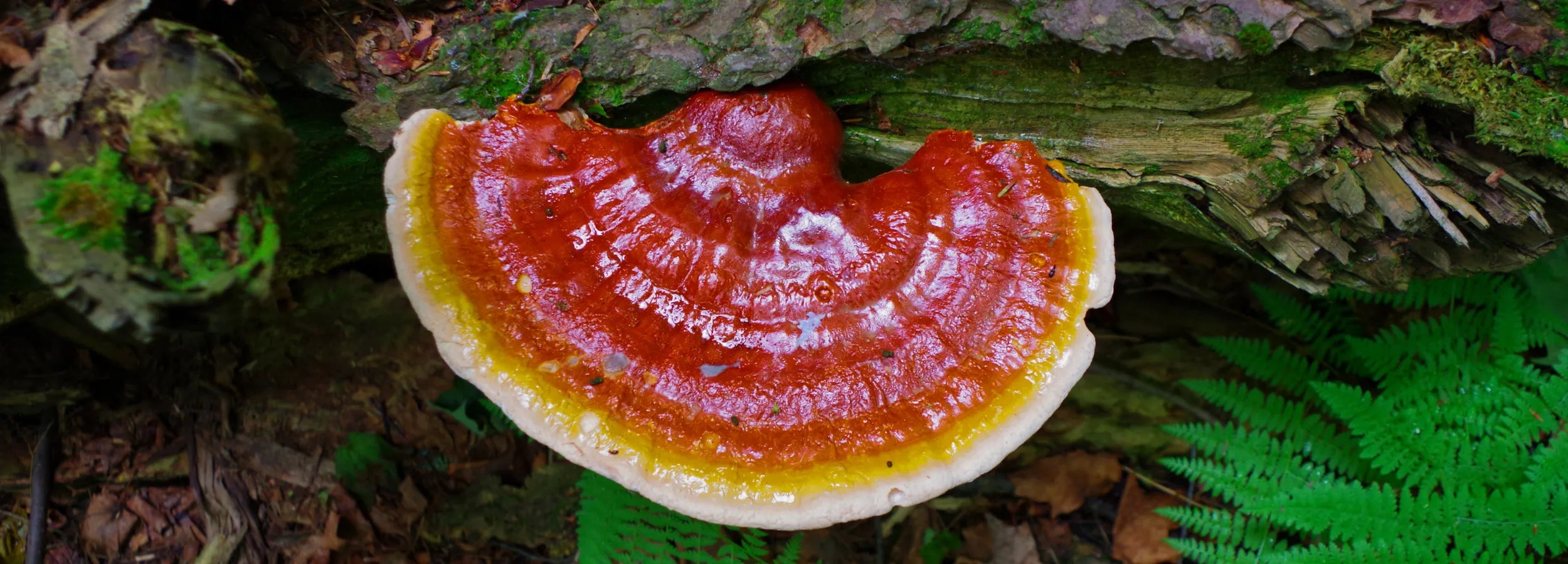
A Review on Medicinal Properties and Historical use of Reishi Mushroom (2024)
ABSTRACT - Mushrooms, terrestrial fungi with epigeous fruiting bodies, adopt a unique lifestyle due to their lack of chlorophyll, setting them apart from non-motile organisms like plants. Over time, mushrooms have played a significant role in human history as both a source of food and medicine. They are abundant in biologically active compounds and nutrients, finding applications in various fields such as food, pharmaceuticals, agriculture, cosmetics, and more. Mushrooms, including Ganoderma lucidum (Reishi), demonstrate diverse effects like immunomodulation and possess
potential therapeutic properties, including antitumor, hepatoprotective, hypocholesterolemic, antiviral, antibacterial, antidiabetic, and antiparasitic activities.

ABSTRACT - Coronavirus disease 2019 (COVID-19) caused by SARS-CoV-2 is characterized by acute respiratory distress syndrome (ARDS) facilitated by cytokine storm and other risk factors that increase susceptibility and complications leading to death. merging as a major global public health challenge, the disease has claimed more than 6 million lives and caused catastrophic global economic disruptions. However, there are concerns about the safety as well as the efficacy of drugs and vaccines presently used to control the pandemic, therefore necessitating intense global search for safe natural products that can effectively and safely combat it. This work reviews studies on lingzhi or reishi medicinal mushroom, Ganoderma lucidum and its properties that may potentially combat SARS-CoV-2 infection and the co-morbidities.

ABSTRACT - Mushrooms have long been integral components of traditional Chinese medicine (TCM), contributing significantly to the holistic approach to health and well-being. This review presents a critical study on mushrooms' integral role in Traditional Chinese Medicine (TCM), emphasizing their potent anticancer properties. Mushrooms have been pivotal in TCM for centuries, contributing to holistic healing practices. The article aims to comprehensively explore mushrooms' historical significance, therapeutic properties, and scientific validation within the framework of TCM, particularly their efficacy in cancer prevention and treatment.
LION'S MANE (Hericium erinaceus)
Lion's mane is one of our most beautiful medicinal mushrooms and is both edible and medicinal. The surge in popularity of Lion's Mane mushroom can be attributed to its well-documented potential to support cognitive health and brain function, making it a sought-after natural supplement in today's fast-paced and health-conscious society.
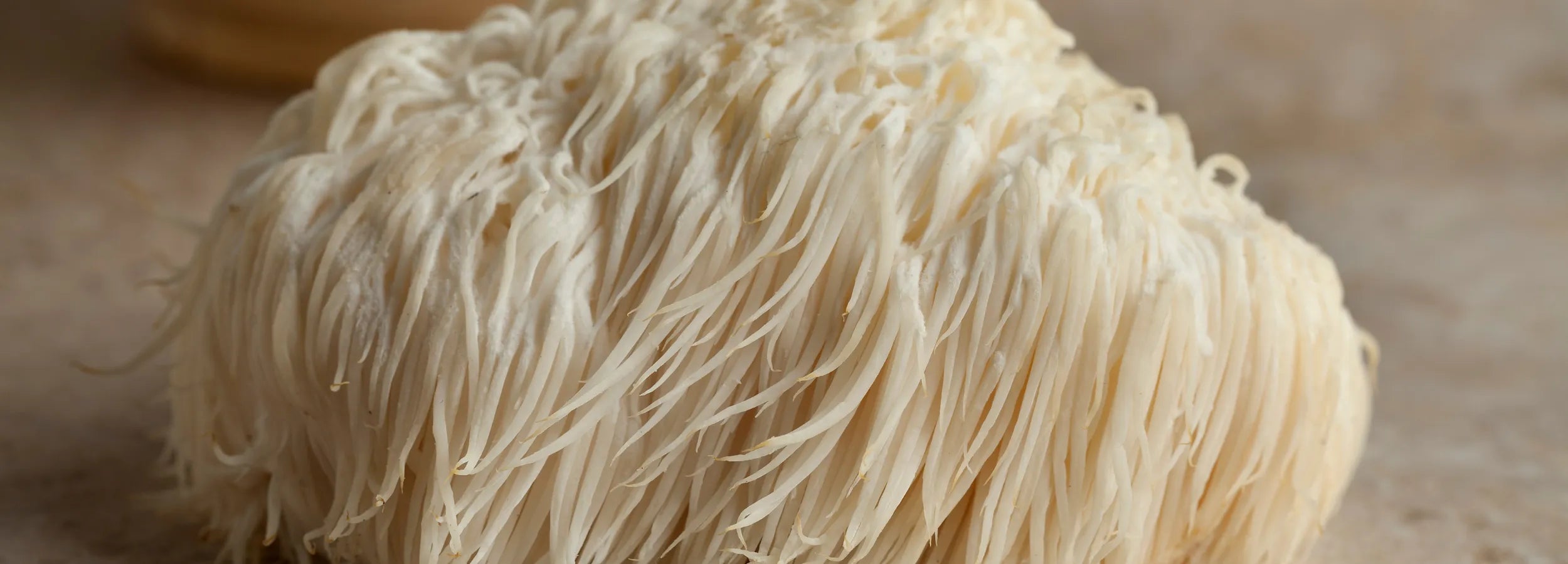
A review of the effects of mushrooms on mood and neurocognitive health across the lifespan (2024)
ABSTRACT - Mushrooms contain bioactive compounds with documented antioxidant and anti-inflammatory actions. Here, we present a systematic evaluation of epidemiological and clinical studies that investigate the role of mushrooms, either as a separate or integral dietary component, on neurocognition and mood. Studies mainly investigated Lion’s Mane (Hericium erinaceus), showing some enhancement of mood and cognitive function in middle-aged and older adults. Further acute and chronic human intervention studies are needed, using adequate sample sizes, employing appropriately sensitive neurocognitive tests, and investigating a range of dietary mushrooms, to confirm the effects of mushroom supplementation on neurocognition and mood in humans.

ABSTRACT -Given the bioactive properties and limited work to date, Hericium erinaceus (Lion’s mane) shows promise in improving cognitive function and mood. However, much of the human research has concentrated on chronic supplementation in cognitively compromised cohorts. Objective: The current pilot study investigated the acute and chronic (28-day) cognitive and mood-enhancing effects of Hericium erinaceus in a healthy, young adult cohort. Conclusions: The findings tentatively suggest that Hericium erinaceusmay improve speed of performance and reduce subjective stress in healthy, young adults.

A growing number of studies is focusing on the pharmacology and feasibility of bioactive compounds as a novel valuable approach to target a variety of human diseases related to neurological degeneration. Among the group of the so-called medicinal mushrooms (MMs), Hericium erinaceus has become one of the most promising candidates. In fact, some of the bioactive compounds extracted from H. erinaceus have been shown to recover, or at least ameliorate, a wide range of pathological brain conditions such as Alzheimer’s disease, depression, Parkinson’s disease, and spinal cord injury. In a large body of in vitro and in vivo preclinical studies on the central nervous system (CNS), the effects of erinacines have been correlated with a significant increase in the production of neurotrophic factors. In this survey, we summarized the current state of knowledge on H. erinaceus dietary supplementation and its therapeutic potential in clinical settings.
TURKEY TAIL (Trametes versicolor)
Turkey Tail's prevalence on almost every continent attest to its
universal medicinal significance, and its immunological prowess is
backed by rigorous human studies.
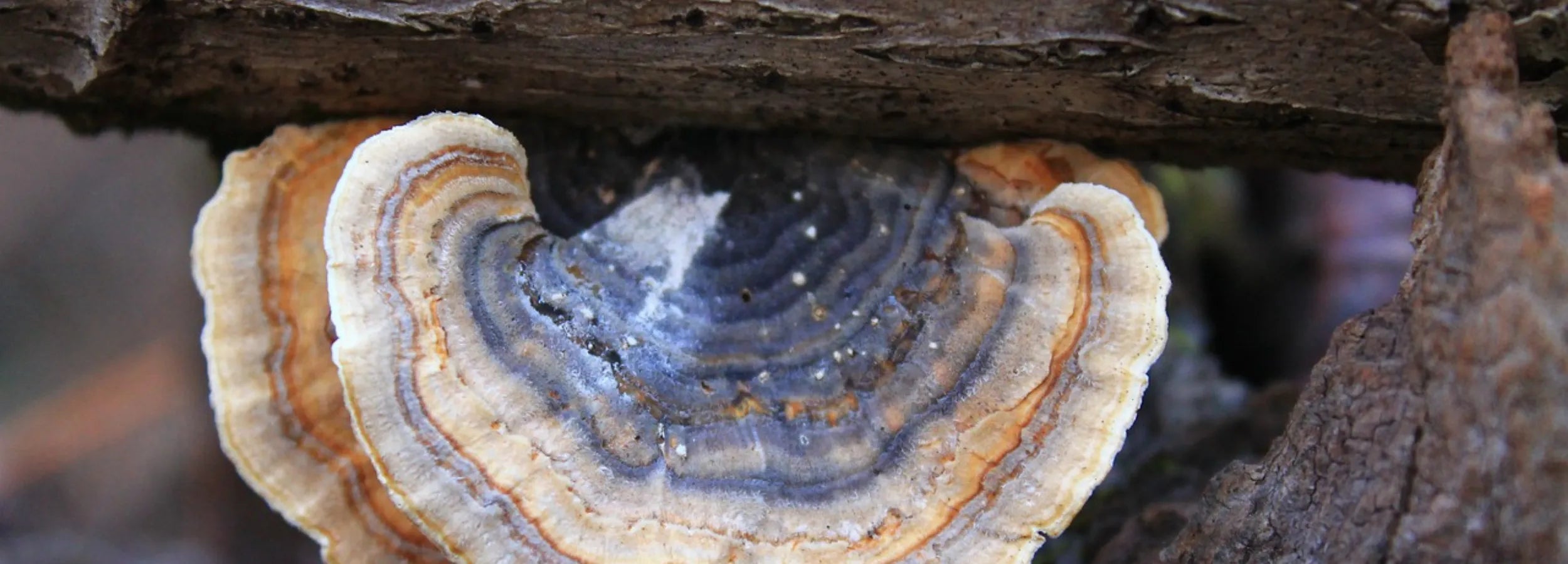
ABSTRACT - Ethnopharmacological relevance. Coriolus versicolor / (CV) also known as Trametes versicolor has been used in traditional Chinese medicine for over 2000 years as a premium medicine for enhancing good health and longevity. The immunomodulatory and anti-cancer effects of polysaccharopeptides (PSP) from cultured CV have been extensively studied; however, the effect and the mechanism of action of other small molecules from CV remain unknown. Aim of the study: we aim to examine the immunomodulatory and anti-cancer effects of the small molecules from CV (SMCV) and identify the active compounds that are responsible for the biological effects against glioblastoma multiforme cells.

Coriolus versicolor (CV) is a common species from the Polyporaceae family that has been used in traditional Chinese herbal medicine for over 2000 years. Among well-described and most active compounds identified in CV are polysaccharopeptides, such as polysaccharide peptide (PSP) and Polysaccharide-K (PSK, krestin), which, in some countries, are already used as an adjuvant agent in cancer therapy. In this paper, research advances in the field of anti-cancer and anti-viral action of CV are analyzed. The results of data obtained in in vitro and in vivo studies using animal models as well as in clinical research trials have been discussed. The present update provides a brief overview regarding the immunomodulatory effects of CV. A particular focus has been given to the mechanisms of direct effects of CV on cancer cells andangiogenesis. A potential use of CV compounds in anti-viral treatment,
including therapy against COVID-19 disease, has also been analyzed based on the most recent literature.

Cancer is the leading cause of mortality globally. With anticancer medications causing severe adverse effects, understanding the role of alternative and efficacious anticancer treatments with minimal or no side effects can be beneficial. Edible mushrooms have been associated with certain health benefits and exhibit a broad range of pharmacological activities, including anti-inflammatory and immunomodulating activities.
The anticancer potential of different mushrooms is now being tested. The goal of this scoping review was to discuss the most recent and available evidence on the therapeutic uses of medicinal mushrooms in cancer treatment, specifically those cancers with some of the highest mortality rates (i.e., gastric, breast, and colorectal cancer). Randomly controlled trials, clinical trials, and retrospective cohort studies (with placebo group) with human subjects published between 2012-2023 were searched using the databases Embase, Ovid MEDLINE, Cumulative Index to Nursing and Allied Health Literature (CINHAL), and Alt HealthWatch.
CORDYCEPS (Cordyceps militaris)
Cordyceps is a genus of Ascomycetes, known as entomopathogenic fungi. Its medicinal use was first recorded in a 15th century Tibetan text whereas others suggest the first written accounts date back to the Tang Dynasty from 620AD.
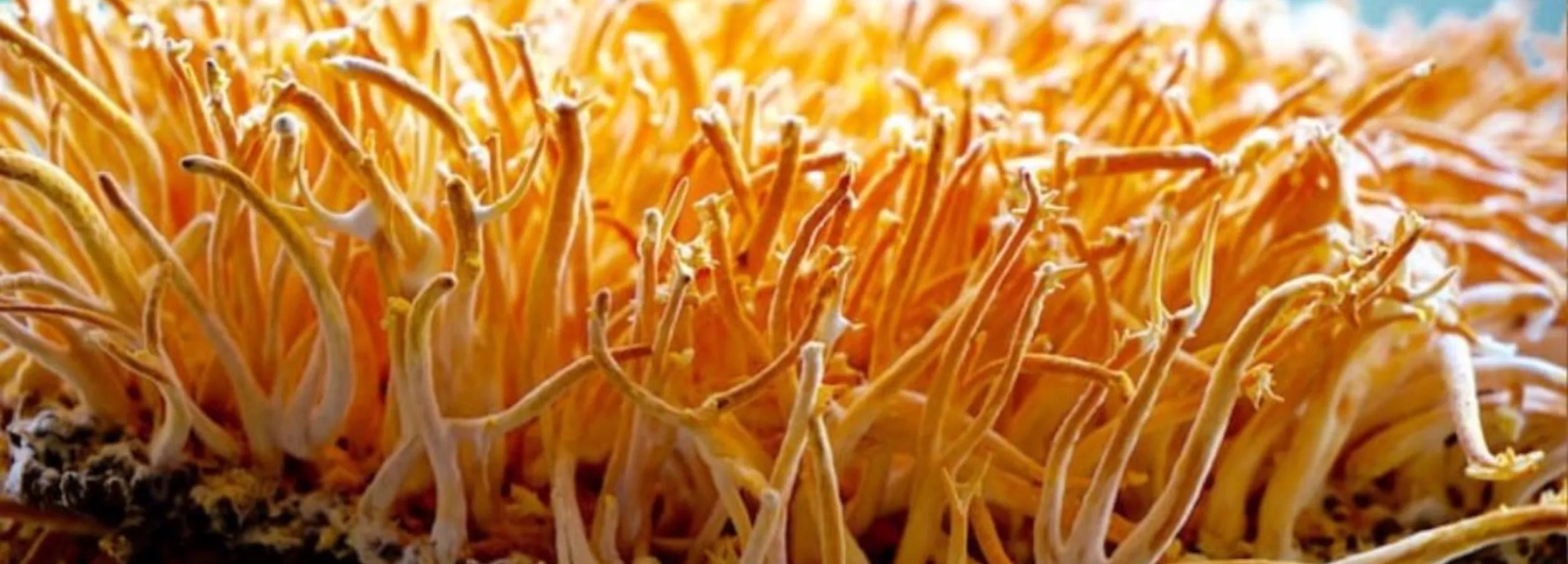
A brief review on the medicinal uses of Cordyceps militaris (2023)
ABSTRACT: Cordyceps, a popular Chinese medication, is made by drying caterpillar-borne Cordyceps fungus. The parasite needs an insect host or larvae host to survive. To strengthen those who were lacking in vitality, it was administered in tonic form. The biological effects of Cordyceps species are well documented. Its medicinal properties are because of the chemical constituents present in the mushroom namely cordycepin, cordymin, polysaccharides, glycoprotein, ergosterol, and other extracts.

ABSTRACT: Cordyceps, also known as “zombie fungus”, is a non-poisonous mushroom that parasitizes insects for growth and development by manipulating the host system in a way that makes the victim behave like a “zombie”. These species produce promising bioactive metabolites, like adenosine, β-glucans, cordycepin, and ergosterol. Cordyceps has been used in traditional medicine due to its immense health benefits, as it boosts stamina, appetite, immunity, longevity, libido, memory, and sleep. Neuronal loss is the typical feature of neurodegenerative diseases (NDs) (Alzheimer’s disease (AD), Parkinson’s disease (PD), multiple sclerosis (MS), amyotrophic lateral sclerosis (ALS) and neurotrauma. Both these conditions share common pathophysiological features, like oxidative stress, neuroinflammation, and glutamatergic excitotoxicity.

Cordyceps militaris as an alternative source of food, nutrition and medicine (2024)
ABSTRACT: In 2020 Covid 19 outbreak wreaked havoc on the entire world. Through constant hard days, the pandemic has taught us how important it is to have better immunity in our body to avoid diseases like covid 19. In the present-day scenario, there are a handful of factors like pollution, adulterated food items, chemical fertilizers, and pesticides, etc. which are slowly decreasing our immunity. In such a situation, Cordyceps militaris has emerged as a great solution. Cordyceps militaris is a medicinal mushroom, its products have been used as medicine in China for centuries, slowly, Cordyceps militaris is gaining fame in India and many other countries due to its exceptional immunomodulatory and other medicinal properties. Nutrition and immunity are two of the essential factors behind a healthy life. Cordyceps militaris imparts a positive effect on both.
CHAGA (Inonotus obliquus)
Chaga has become the recreational (health) beverage of choice for numerous consumers and used in Russian folk medicine for thousands of years.

Therapeutic properties of Inonotus obliquus (Chaga mushroom): a review (2023)
ABSTRACT: Inonotus obliquus, also known as Chaga, is a medicinal mushroom that has been used for therapeutic purposes since the sixteenth century. Collections of folk medicine record the application of Chaga for the treatment of diseases such as gastrointestinal cancer, diabetes, bacterial infection, and liver diseases. Modern research provides scientific evidence of the therapeutic properties of I. obliquus extracts, including anti-inflammatory, antioxidant, anticancer, anti-diabetic, anti-obesity, hepatoprotective, renoprotective, anti-fatigue, antibacterial, and antiviral activities. Various bioactive compounds, including polysaccharides, triterpenoids, polyphenols, and lignin metabolites have been found to be responsible for the health-benefiting properties of I. obliquus. Furthermore, some studies have elucidated the underlying mechanisms of the mushroom’s medicinal effects, revealing the compounds’ interactions with enzymes or proteins of important pathways. Thus, this review aims to explore available information on the therapeutic potentials of Inonotus obliquus for the development of an effective naturally sourced treatment option.

Chaga mushroom triterpenoids as adjuncts to minimally invasive cancer therapies: A review (2023)
ABSTRACT: Cancerhas become the second leading cause of death in the world. Integrative cancer therapy management is continuously evolving to enhance treatment outcomes. Chaga mushroom (Inonotus obliquus) is a parasitic fungus acclaimed to contain Pharmaceutical and nutraceutical value in the fight against cancer. In particular, triterpenoid constituents derived from Chaga mushrooms have been recognized for their anti-cancer activity after distinguished cytotoxicity was repeatedly observed in cancer cells treated in vitro with lipophilic fractions of extract compared to aqueous ones. Studies that investigate the anti-cancer activity of Chaga mushroom triterpenoids are reviewed in this article to determine which cancer cell lines demonstrate the greatest susceptibility to them while highlighting the structure–activity relationships that are involved. Triterpenoid supplementation as an adjunct to cancer treatment may be a viable option as inotodiol and 3-β-22 α-dihydroxylanosta-8, 25-diene-24-one have been shown to exhibit anti-cancer activity similar to that of conventional drugs. Advances in addressing bioavailability challenges are also included in this review as studies include in vivo components.

Chaga mushroom: a super-fungus with countless facets and untapped potential (2023)
Inonotus obliquus (Chaga mushroom) is an inexpensive fungus with a broad range of traditional and medicinal applications. These applications include therapy for breast, cervix, and skin cancers, as well as treating diabetes. However, its benefits are virtually untapped due to a limited understanding of its mycochemical composition and bioactivities. In this article, we explore the ethnobotany, mycochemistry, pharmacology, traditional therapeutic, cosmetic, and prospective agricultural uses. The review establishes that several secondary metabolites, such as steroids, terpenoids, and other compounds exist in chaga. Findings on its bioactivity have demonstrated its ability as an antioxidant, anti-inflammatory, antiviral, and antitumor agent. The study also demonstrates that Chaga powder has a long history of traditional use for medicinal purposes, pipe smoking rituals, and mystical future forecasts. The study further reveals that the applications of Chaga powder can be extended to industries such as pharmaceuticals, food, cosmetics, and agriculture. However numerous publications focused on the pharmaceutical benefits of Chaga with few publications on other applications.
MAITAKE (Grifola frondosa)
Maitake is both edible and medicinal and satisfies the Hippocrates saying 'Let food be your medicine, and medicine your food.' Various in vitro and in vivo studies suggest it has promising activity.
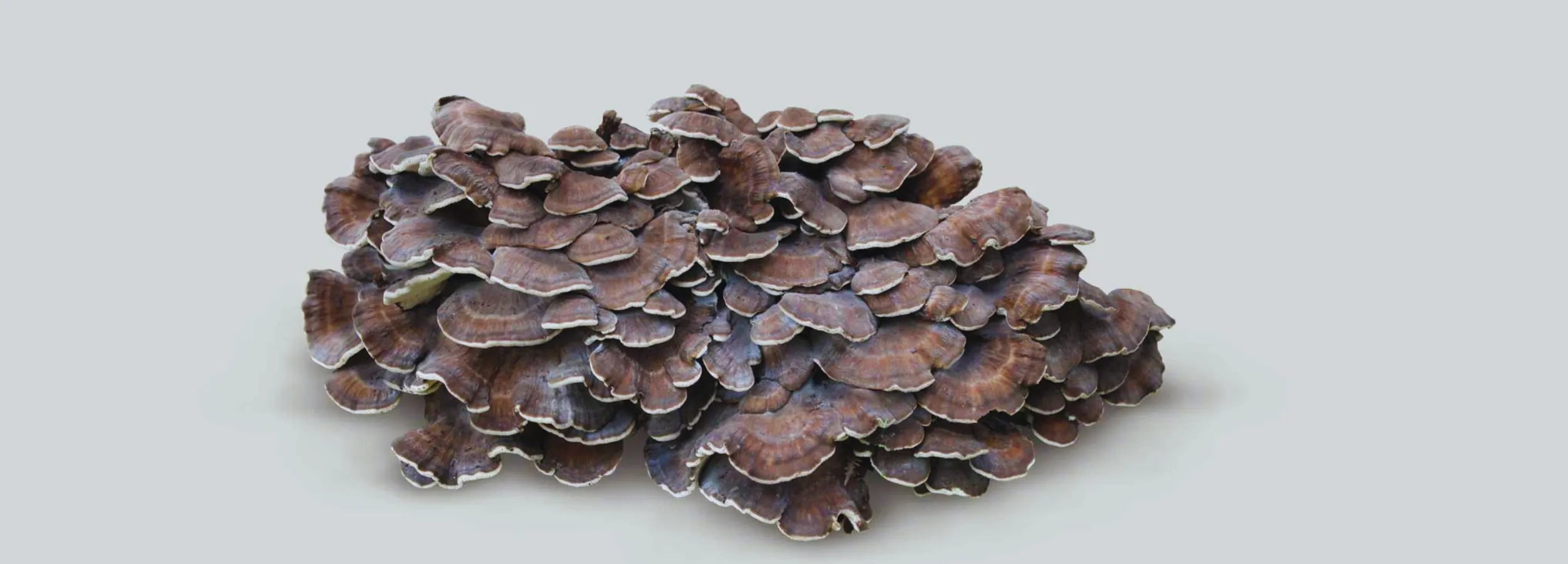
This literature review provides an up-to-date exploration of the multifaceted attributes of maitake mushrooms (Grifola frondosa), elucidating their bioactive phytochemicals and diverse health advantages, including their substantial role in supporting human health and potential incorporation into the medicinal industry. Carbohydrates and protein are the major constituents contributing to the dry weight of G. frondosa, taking up around 70–80 % and 13–21 %, respectively, with emerging research linking these constituents to various health benefits. By synthesising current research findings, this review emphasises the substantial role of maitake mushrooms in supporting human health and underscores their potential incorporation into the medicinal industry.
To further advance our understanding, future research should delve into the mechanisms underlying their health-promoting effects, with a focus on conducting quantitative studies to elucidate physiological pathways and potential drug interactions. Additionally, exploring their integration into functional foods or nutraceuticals through quantitative assessments of bioavailability and efficacy will be crucial for maximising their therapeutic benefits. This review aims to provide comprehensive insights, catalysing further research and innovation in utilising maitake mushrooms for improved well-being and industry advancement.

Preventative and Curative Properties of Reishi and Maitake Mushrooms in Cancer (2023)
Medicinal mushrooms have considerable therapeutic (130 different) properties, including anticancer, antiviral, antibacterial, antiparasitic, antifungal, antioxidant, radical scavenger, cardiovascular, anti-hypercholesterolemic, detoxifying, hepatoprotective, and antihyperglycemic actions. In terms of nutrition, mushrooms are considered to be valuable food (nutraceuticals) and a source of therapeutics. Cancer patients worldwide frequently supplement traditional anticancer therapy with complementary alternative drugs and natural bioactive made from organic sources like mushrooms, including the well-known maitake or Reishi medicinal mushroom.
Ganoderma lucidum (G. lucidum – Reishi) and Grifola frondosa(G.frondosa–maitake) are species of mushroom with a long history in traditional medicine to lengthen life and improve health. Since the 1970s, they have been intensively grown globally and promoted due to the rising consumption trend. In addition to exerting anticancer characteristics, they are also effective in preventing and treating numerous disorders. The principal bioactive components in G.lucidum and G.frondosa include terpenoids and polysaccharides, which are responsible for the anticancer effects. This book chapter focuses on the hemotherapeutic properties of G.lucidum and G.frondosa.

Neurodegeneration is one of the most common manifestations in an aging population. The occurrence of oxidative stress and neuroinflammation are the main contributors to the phenomenon. Neurologic conditions such as Alzheimer's disease (AD) and Parkinson's disease (PD) are challenging to treat due to their irreversible manner as well as the lack of effective treatment. Grifola frondosa (Dicks.: Fr.) S.F. Gray, or maitake mushroom, is believed to be a potential choice, a therapeutic agent for neurodegenerative diseases.
G.frondosa is known to be a functional food that has a wide variety of medicinal purposes. Thus, this review emphasizes the neuroprotective effects and the chemical composition of G.frondosa. Various studies have described that G.frondosa can protect and proliferate neuronal cells through neurogenesis, antioxidative, anti-inflammatory, and anti-β-amyloid activities. The mechanism of action behind these therapeutic findings in various in vitro and in vivo models has also been intensively studied.
In this mini review, we also summarized the chemical composition of G.frondosa to provide a better understanding of the presence of nutritional compounds.
SHIITAKE (Lentinula edodes)
Shiitake (Lentinula edodes) is one of the most cultured and consumed mushrooms around the world. With more complexity in medical science and phenomenon like antibiotic resistance, have led to the search for alternatives for disease treatment and prevention.
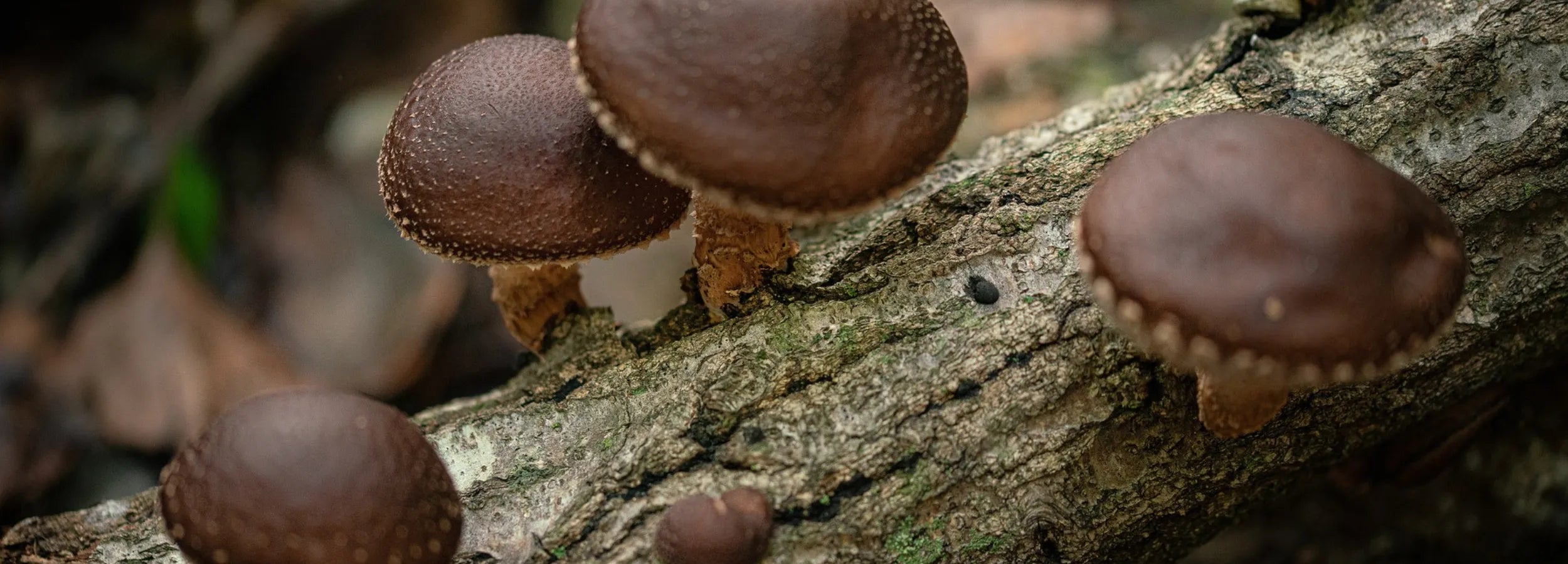
ABSTRACT: Mushrooms are generally regarded as useful products with multiple applications in the food and health industry. Shiitake mushrooms contain essential macro and micronutrients as well as many bioactive compounds, including polysaccharides, antioxidants, dietary fiber, and ergosterol. Bioactive compounds can be helpful for maintaining the good health of the users and preventing them from diseases. Shiitake mushroom contains phenolics, polysaccharides, sterols, that play role in bodily functions resulting in improved health of the individuals.
Scope and approach - The review has focused to uncover the therapeutic potential of L.edodes and description of several nutraceutical properties of the shiitake mushroom that can be helpful in preventing and treating diseases. The properties like antimicrobial, antiviral, anticancer, anti-obesity, antidiabetic, antioxidant, etc. are discussed in this review with more focus on the latest update in this context.

Cancer is the leading cause of mortality globally. With anticancer medications causing severe adverse effects, understanding the role of alternative and efficacious anticancer treatments with minimal or no side effects can be beneficial. Edible mushrooms have been associated with certain health benefits and exhibit a broad range of pharmacological activities, including anti-inflammatory and immunomodulating activities. The anticancer potential of different mushrooms is now being tested. The goal of this scoping review was to discuss the most recent and available evidence on the therapeutic uses of medicinal mushrooms in cancer treatment, specifically those cancers with some of the highest mortality rates (i.e., gastric, breast, and colorectal cancer). Randomly controlled trials, clinical trials, and retrospective cohort studies (with placebo group) with human subjects published between 2012-2023 were searched using the databases Embase, Ovid MEDLINE, Cumulative Index to Nursing and Allied Health Literature (CINHAL), and Alt HealthWatch.

In this study, we examined the effects of Lentinula edodes mycelia (LEM) on fatigue and immune function in healthy subjects. 22 people were randomly assigned in a 11 ratio to the LEM ingestion group and the placebo group. Daily oral ingestion of LEM for 4 weeks (600 mg/day) significantly improved the VAS fatigue score compared with before treatment (p<0.01). Additionally, NK cell activity was increased by ingestion of LEM (p<0.01) and was higher level compared to the placebo group (p<0.05). These results indicate that oral ingestion of LEM may improve the feeling of fatigue.

